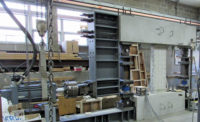SFRC—typically used for crack control in footings, piles, slabs, walls, beams, columns and roofs—is not yet in the seismic building code. For permitting, Kopczynski applied for use of the SFRC under Section 104.11 of the 2006 International Building Code, which allows for alternate materials, design and methods.
Under Section 104.11, the engineer of record must show the building official the alternate will provide equivalent performance. "I said we would accept the change, proposed after the building was approved, as code-conforming if the system was peer-reviewed," says Steven Pfeiffer, engineering and technical codes manager in Seattle's Dept. of Planning and Development (DPD). "It was a challenging process," he adds.
DPD required peer reviews from a practitioner and an academic. Until SFRC link beams are in the code, which could take six years, DPD will require a review for each SFRC project, says Pfeiffer.
Kopczynski based his scheme on information from performance tests at the University of Michigan (ENR 4/19/10 p. 12). The first snag in the review process was that the initial submittal did not match the tested assemblies regarding steel, fiber content, shear demand and aspect ratios, says Pfeiffer. There was also concern about the SFRC mix.
For the reviewers, the biggest challenge was that "the Michigan tests alone were not sufficient to extrapolate to higher levels of shear stress," says Joe Maffei, who did the review with Richard Sause, a professor of engineering at Lehigh University, Bethlehem, Pa.
Eventually, Maffei and Sause found other tests they could use. However, based on their concerns, Kopczynski changed the shape of the beam.
"We all were in agreement that fibers in concrete can have a number of performance benefits in terms of shear stress and ductility," says Maffei, who was a principal with Rutherford & Chekene when he did the review last year. A month ago, Maffei left R&C to form Maffei Structural Engineering, Oakland, Calif.
In the end, Seattle's DPD required fiber from the supplier for the Michigan tests. It also insisted on 200 lb of fiber per cu yd of concrete to match the tests. "If you have a lot of testing, you can sometimes interpolate and extrapolate, but [with] limited testing, you have to build what was tested," says Pfeiffer.
Trial Run
The city also was concerned about sufficient slump in the SFRC to allow proper placement and vibration. During a trial run, the team discovered the high dosage lowered the slump, which measures the concrete's fluidity, to less than two inches. It was too thick to place.
Ultimately, the team used a chemical admixture that created self-consolidating concrete. The result was a workable, 8-in. slump, acceptable to the reviewers.












Post a comment to this article
Report Abusive Comment